List of Top 10 Folk Dance of Chhattisgarh
Pinkey Sharma |
Dance |
2024-12-07 |
null mins read

Table of Contents
- Folk dances of Chhattisgarh
- List of Famous Folk Dances of Chhattisgarh
- Pandavani
- Raut Nacha Dance
- Karma Dance
- Saila Dance
- Panthi Dance
- Suwa Dance
- Suwa Dance
- Kaksar Dance
- Cherchera Dance
- Khada Nacha Dance
- Gendi Dance
- Why Are Folk Dances Important in Chhattisgarh
- Cultural Significance of Chhattisgarh Folk Dances
- How to Experience Folk Dances of Chhattisgarh
- Wrap Up
Folk dances in India are a beautiful way to express stories, traditions & emotions through movement and music. The rich history and culture of the society revolve much around it. Every state has its own folk dances which reflects their way of life.Find out more about Indian folk dances and how they have been passed down over time
Chhattisgarh, located in central India, is especially known for its beautiful folk dances. These dances highlight the close link among people, their customs, and their surroundings. Starting from celebrations to ceremonies, the folk dances of Chhattisgarh are important in preserving the cultural legacy of this state. Read how our dance curriculum has tied up with preserving Chhattisgarh's rich cultural heritage in its folk dances as well.
We will look into the traditional dances of Chhattisgarh, their background, and their significance in this Blog.
Folk dances of Chhattisgarh
A Glimpse of different types of folk dances in Chhattisgarh
List of Famous Folk Dances of Chhattisgarh
Folk dances are one of the important parts of Chhattisgarh's vibrant culture and its traditions. Each dance has a different style, purpose, & significance which makes it a vital element of the state's identity. Below is the list of most famous folk dances of Chhattisgarh, along with a brief description of each.
|
Dance Name |
Short Brief |
|
Pandavani |
A storytelling dance narrating tales from the Mahabharata. |
|
Raut Nacha |
A Krishna-inspired dance performed during the Gaur festival. |
|
Karma Dance |
A ritual dance performed around the Karma tree for prosperity. |
|
Saila Dance |
A joyful dance celebrating the harvest season. |
|
Panthi Dance |
A spiritual dance performed by the Satnami community. |
|
Suwa Dance |
A graceful folk dance performed by women, celebrating nature and the harvest season, full of joyful movements. |
|
Kaksar Dance |
A slow, spiritual dance performed by tribal communities to express devotion and seek blessings for prosperity. |
|
Cherchera Dance |
A vibrant, energetic dance performed during festivals, symbolizing joy, unity, and community spirit. |
|
Khada Nacha Dance |
A powerful folk dance performed by men, symbolizing strength, valor, and warrior spirit. |
|
Gendi Dance |
A unique dance involving spinning movements, performed during Diwali. |
Pandavani
Pandavani( in Hindi: पंडवानी) is a storytelling dance firmly originated from Chhattisgarh's oral customs. Especially emphasizing the Pandavas, it brings the great stories of the Mahabharata to life. Using music, rhythm, and dramatic facial expressions, the actor plays several story characters—including Yudhishthira, Arjuna, and Bhima—in turn. For centuries, Chhattisgarh's culture—especially in the tribal areas—has included this dance as a mainstay.
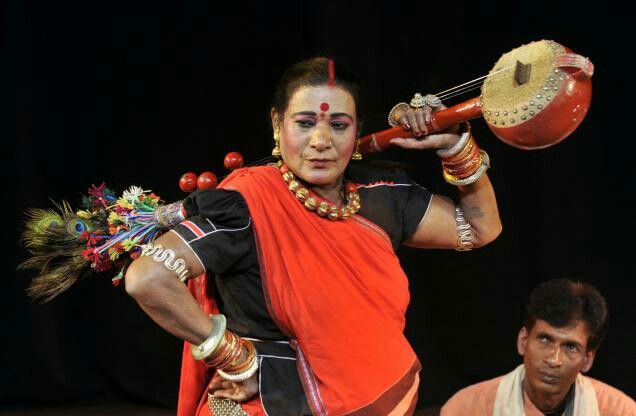
Pandavani Performed by Teejan Bai(source:1)
Origin and History:-
Pandavani is thought to have come from the towns of Chhattisgarh and has roots in the old art of telling stories through singing. In rural India, this tradition began as a way to tell stories and history out loud. The Mahabharata was told through Pandavani. The performance format is thought to have evolved, with the introduction of musical instruments and dramatic narration in the 18th century. In the 20th century, it gained significant popularity due to the efforts of artists like Teejan Bai, who brought international recognition to this dance form.
Performing Style (Steps on How the Dance is performed):-
-
Step 1: The Introduction:– The performance begins with the narrator (usually a solo performer) who tells the story of the Mahabharata in a rhythmic voice. The dancers accompany the narrator by mimicking the story's character through expressive movements.
-
Step 2: Character Representation:– As the narrator recites different parts of the epic, dancers move to portray specific characters. For instance, one dancer may mimic Bhima with strong and forceful movements, while another may portray Draupadi with gentle and graceful gestures.
-
Step 3: Symbolic Gestures and Postures:- The dancers use hand gestures (mudras) to tell there emotions and actions for the drama. Raised arms, for instance, may represent victory, but clasped hands may represent prayer or humility.
-
Step 4: Flowing Dance Movements:- The dancers move smoothly, swiveling their bodies and stepping in circles or zigzags. They use their hands to highlight significant parts of the story.
Musical Instruments Used:-
-
Dholak:- This two-headed drum is an important part of the show because it keeps the beat steady during both the dance and the story. The dholak is played in a regular way to make syncopated beats that go with the dancers' steps.
-
Tambura:- This gourd-based instrument gives the performance an additional layer of melodic rhythm, complementing the dholak.
-
Mandar:- The Mandar adds an energetic rhythm to the dance, especially during the most intense moments of the story, where the characters are in conflict.
-
Flute:- The flute is used to produce a sweet flow of sound, and helps the dancer's movements with soothing and spiritual music that aligns with the mythological significance of the dance.
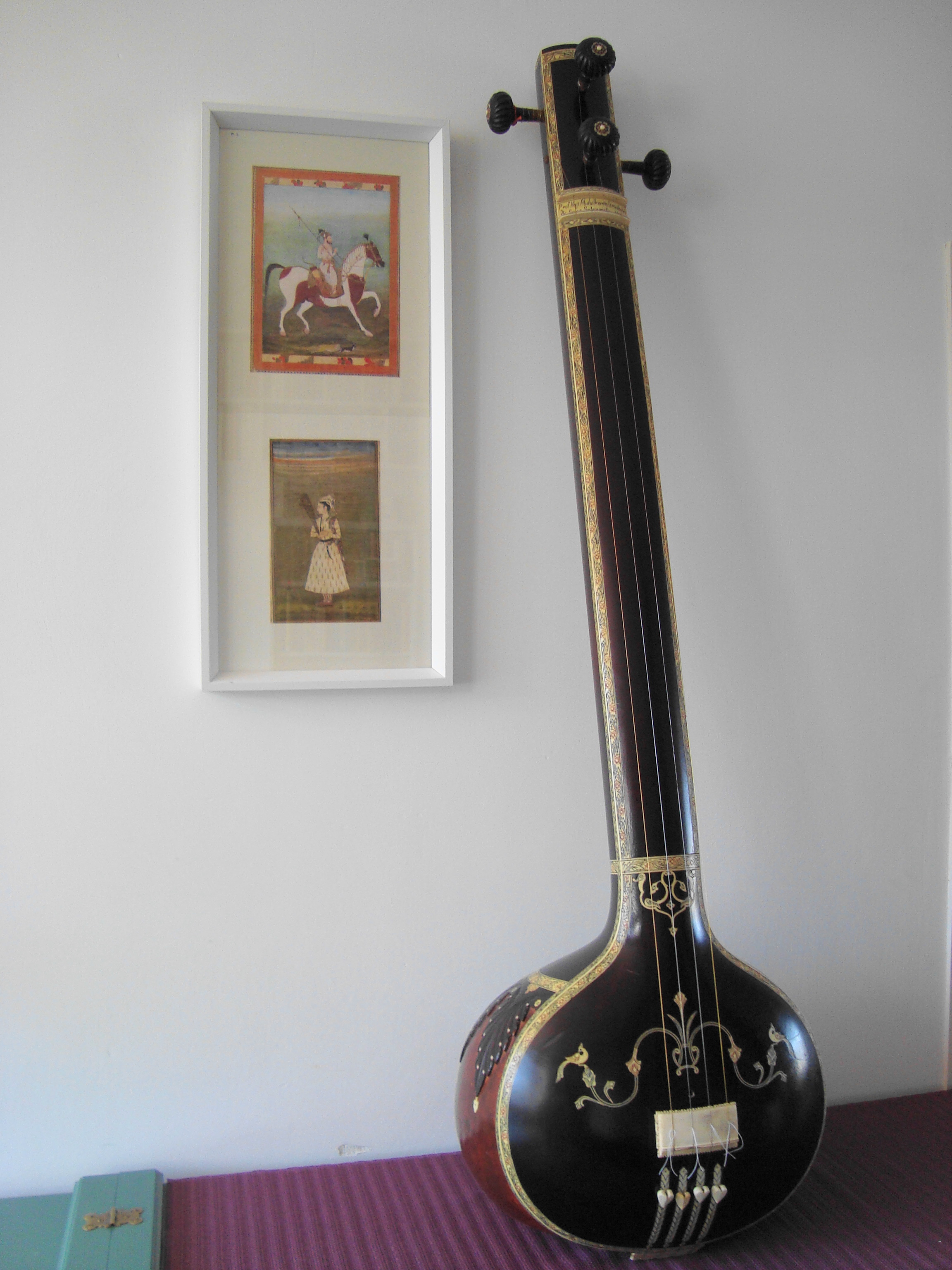
Tambura Musical Instrument
Significance for Children:-
Pandavani provides children with a unique method to connect with Indian mythology and history. Children learn about the Mahabharata as well as Indian cultural values such as loyalty, justice, and wisdom by participating in dancing. Pandavani performances assist children in developing abilities in storytelling, music, and dramatic arts, which aids in their intellectual and creative development. Explore our Pandavani-Inspired activities that help develop these traits
Raut Nacha Dance
Raut Nacha (in Hindi: राउत नाच) is one of the famous folk dances of Chhattisgarh that is mostly done by the Yadav community. During the Gaur event, which honors Lord Krishna's actions, especially his love for cows and nature, this dance is performed. Raut Nacha, which means "dance of the cowherds" in English, is done by men dressed as Krishna and his friends. This lively and energizing dance stands for happiness, loyalty, and group spirit.
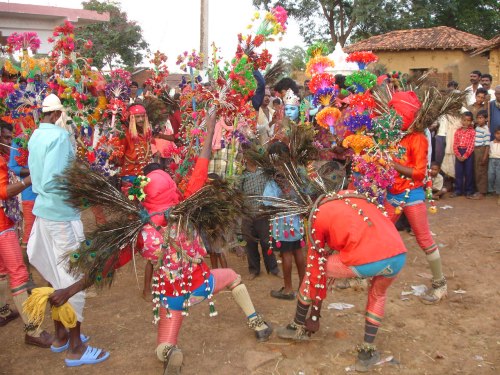
Performers performing Raut Nach(Source-2)
Origin and History:-
Raut Nacha has its origins in the Krishna cult. The dance was initially performed as a devotional offering to Lord Krishna. Historically, it is believed to have been first performed centuries ago in the villages of Chhattisgarh during religious and agricultural festivals. The dance form remains deeply tied to the Raut (caste), agricultural community, where the community celebrates the annual harvest through rituals dedicated to Lord Krishna. The dance was popularized in the 19th century and has remained an important cultural symbol in the state.
Performing Style (Steps on How the Dance is performed):-
-
Step 1: Getting into Position: The dancers start by standing in two lines facing each other, which can be seen as a war or a scene from Krishna's story.
-
Step 2: Move with sticks. One thing that makes this dance unique is the rhythmic hitting of sticks. Dancers hold wooden sticks and time their fights. They usually do this with a partner or a group.
-
Step 3: Agility and Footwork: The dancers jump and move their feet quickly to imitate Krishna's funny tricks. They generally emit the rhythm of Krishna's sacred actions by hopping or spinning in circles.
-
Step 4: Telling Stories: As they move in patterns, the dancers act out stories from Krishna's life, especially his jokes and raslilas (divine dances).
Musical Instruments Used:-
-
Raut Nacha plays this big bass drum a lot. The beat is kept steady with sticks so that the dancers can keep up. It is played quickly and loudly.
-
Mandar: A more classic drum that turns things up a notch and makes them more intense. The Mandar supports the dhol and Tasha by adding layers of percussion.
-
Toshi: A big kettle drum that speeds up the dance and makes the beat stronger.
-
Flute: The flute, which is sometimes played to add music to the percussion beats, represents Krishna's kind and happy personality.
Significance for Children:-
Indian children of our countryside can learn about Lord Krishna and the spiritual meaning of cows through Raut Nacha. It's a fun and educational practice for kids because it helps them learn rhythm, work together, and coordinate their bodies. Children feel a strong connection to their culture through dance, which also teaches them values like dedication, community service, and respect for the environment.
Karma Dance
The Karma Dance is a traditional dance of Chhattisgarh that is done at the Karma event, which is a celebration of many tribal groups. The ritual is built around the Karma tree, which is a sacred tree thought to bring good luck and health. The dance is a gift to the tree that shows the community cares about the earth and wants a good harvest.
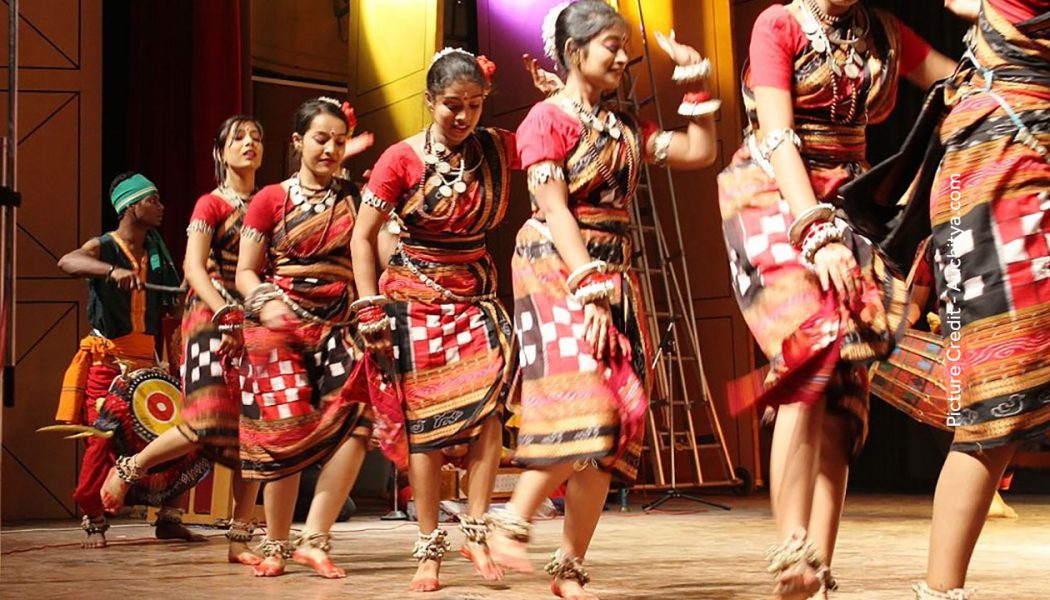
Local Tribe performing Karma dance( Source-3)
Origin and History:-
There are many tribes in Chhattisgarh that practice the Karma Dance. The main groups that do it are the Gonds, Baigas and Oraons. The Karma event starts the harvest cycle. It takes place during the monsoon season. Animistic customs, which put a lot of value on worshiping nature and trees, are where the dance comes from. Since it was first written down in the early 1800s, the area's tribal identity has been passed down through generations.
Performing Style (Steps on How the Dance is performed):-
-
Step 1: Formation of a Circle: The dancers form a circle around the Karma tree to show how life and wealth go in cycles.
-
Step 2: Hand Motions: As they take regular swaying or stomping steps, the dancers lift their hands to the sky. These actions show that they are hopeful for a good harvest and a bright future.
-
Step 3: Stamping and rotating your feet: In this part of the dance, you stamp your feet together and time each step to the beat of the drum. The way the seasons and life cycle work together is shown by spinning or turning in a circle.
-
Step 4: The Dance of Harvest: The dancers quickly step from side to side as they move, making it look like they are picking crops.
Musical Instruments Used:-
-
Dholak: This two-headed drum is an important part of the show because it keeps the beat steady during both the dance and the story. The dholak sets the overall pace of the dance by using steady beats to time the dancers' footwork.
-
Tambura: With its soft beats, the tumba is a percussion instrument that goes well with the dance's gentle moves.
-
Chimta: This type of beat is usually used in faster parts of the dance. It adds heightened stress and excitement.
Significance for Children:-
Through the Karma Dance, kids learn how important it is to take care of nature and the environment. It makes people care about farming, trees, and the way things work in nature. Children who participate learn the value of preserving the environment and keeping harmony between people and the natural world—two important principles for sustainability in the present era.
-
Saila Dance
The Saila Dance is a customary dance performed at harvest celebrations in Chhattisgarh. It is a representation of the ceremonies the tribal communities perform to give thanks to God for a bountiful crop and depicts how joyful they are after the harvest. The dance is full of vitality and hope as the dancers from many tribes move in time with the music.
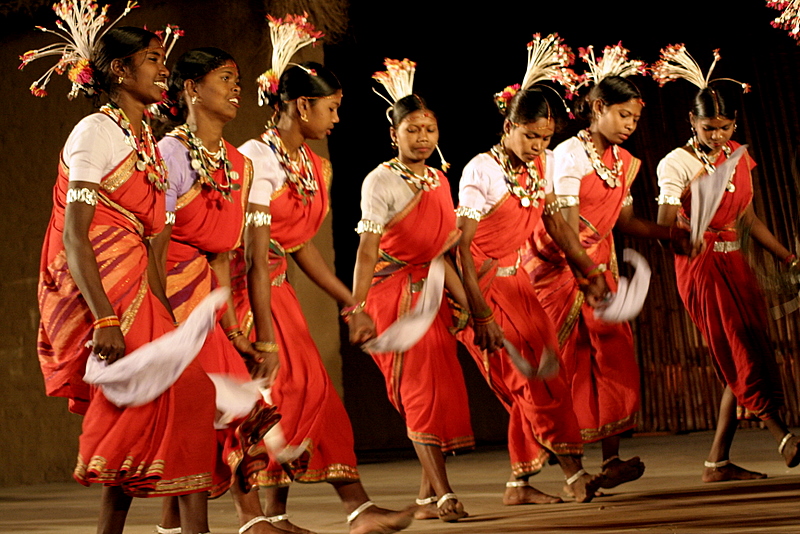
Tribal's Performing Saila Dance(Source-4)
Origin and History:-
Saila Dance originates from the agricultural practices that are practiced by the Chhattisgarh tribal community. Initially, it was done to mark the conclusion of a harvest season that was particularly fruitful. It is believed that the dance was first performed by the Gonds and other indigenous people in the early century of 17th century. By taking this action, they were able to secure their future and express their gratitude to the gods for the plentiful harvest.
Performing Style (Steps on How the Dance is performed):-
-
Step 1: Posture and Formation: To symbolize the group's cohesion and the ties that bind it together, the dancers start by positioning themselves in semi-circular patterns.
-
Step 2: Swinging Motions: Saila is known for its soft swaying, in which dancers mimic the swaying of crops in the wind by moving from left to right.
-
Step 3: Quick Turns: To symbolize the joy of harvest, the dancers do quick turns while frequently jumping or stomping their feet.
-
Step 4: Group Synchronization: As the harvest season is honored, the dance gets more vivacious. The actors move in unison as they maintain flawless synchrony.
Musical Instruments Used:-
-
Big Dholak: The dancers' tempo is maintained while they swing and turn thanks to the constant rhythm provided by the dholak.
-
Chimta: This instrument highlights specific dancing actions by adding crisp, emphasized beats.
Significance for Children:-
Children have a great opportunity to learn the value of perseverance and the benefits of nature through Saila Dance. Additionally, it instills in them a sense of solidarity and group duty by teaching them about the community aspect of harvest festivities. Youngsters enthusiastically engage in the entertaining and instructive dance, which strengthens their ties to their cultural heritage.
Panthi Dance
The Panthi Dance is a religious folk dance from Chhattisgarh that is mostly done by people from the Satnami group. The Satnam Panth is a spiritual movement that was started by Guru Ghasidas in the early 1800s. This dance has deep roots in their beliefs. The dance is a way to honor Guru Ghasidas's teachings and to celebrate the spiritual and social ideals of the community. There is a strong link between the dance and the Satnami faith, and the moves are very graceful.
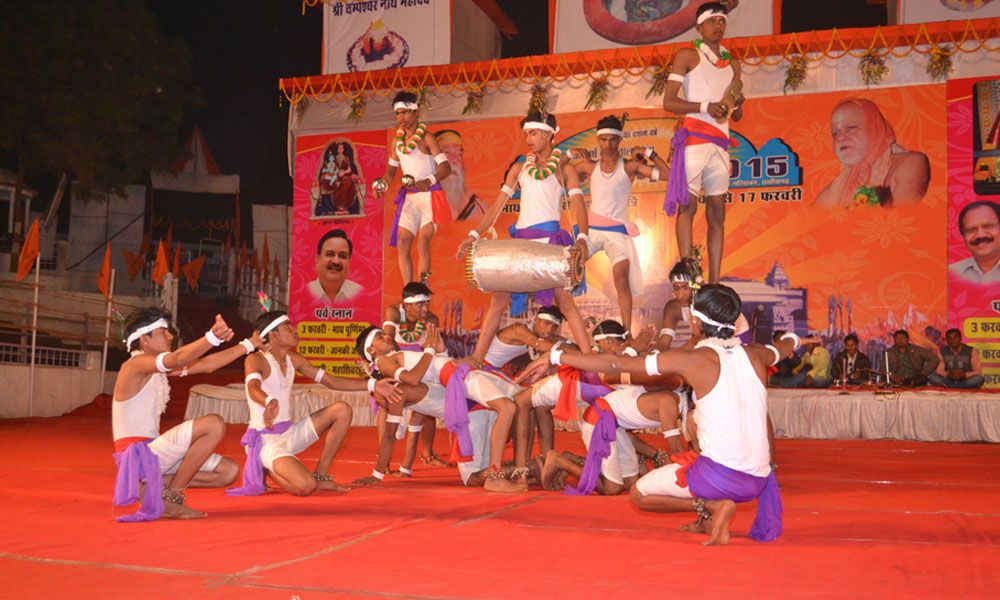
Glimpse of Panthi dance(Source-5)
Origin and History:-
Guru Ghasidas started the Satnami movement in 1820 in the Koriya area of Chhattisgarh. This is where Panthi Dance gets its roots. The Satnamis were followers of Guru Ghasidas, who spoke out against discrimination based on race and stressed that all people are the same. People made the dance to show their love for God and Guru Ghasidas' teachings. Since its origin, it has been an integral part of Satnami festivals and religious occasions.
Performing Style (Steps on How the Dance is performed):-
-
Step 1: Formation of Rows – The dancers often begin in a line or rows, with the leader setting the pace.
-
Step 2: Stomping and Prayers – The performers stomp their feet in time with the drumbeats while keeping their hands folded in prayer. This symbolizes their spiritual connection and devotion.
-
Step 3: Movement Between Rows – Dancers alternate between moving in and out of rows in a synchronized fashion, creating a sense of collective devotion.
-
Step 4: The Ritual Procession – The performance often includes a slow procession, where dancers move towards a central symbolic point, symbolizing the journey to the divine.
Musical Instruments Used:-
-
Dholak – It provides the rhythmic beats, guiding the foot movements and ensuring synchronization between dancers.
-
Nagada – Played in religious festivals, the nagada offers booming beats that provide a spiritual backdrop to the devotional movements.
Significance for Children:-
For children, the Panthi Dance offers a great opportunity to learn about the importance of spirituality, unity, and devotion. It teaches them values such as humility, equality, and respect for all human beings, core tenets of the Satnami faith. By participating in this dance, children not only connect to their religious roots but also develop a deeper understanding of community and spirituality. It also provides a wonderful way for children to engage with the rich cultural heritage of Chhattisgarh.
Suwa Dance
The Suwa Dance is a lively folk dance from Chhattisgarh that women mostly do to show how much they love nature and the harvest. At events, especially when it's harvest time, people do this dance to thank nature for all the good things it has given them. There are lots of happy moves in the dance that show how happy the people are.
Suwa Dance
Local Tribes Performing Suwa Dance
Origin and History of Suwa Dance:-
Suwa Dance has its roots in the rural areas of Chhattisgarh, where farming is an important part of life. The dance is closely linked with the agricultural cycle, especially the time of harvest. In the native language, "Suwa", the word for "harvest" shows how it is related to the land and crops.
In the past, women would dance after the harvest to thank the gods for a good crop and enjoy the season's bounty. This dance has become an important part of regional holidays and cultural events over time.
How is Suwa Dance Performed:-
Some dancers move in a circle while singing and clapping to the beat of the music. This is Suwa Dance. These are the steps you need to take:
-
Step 1: Circle Formation: The dancers hold hands and start moving slowly and rhythmically in a circle.
-
Step 2: Steps with Grace: The dancers' feet move to the beat of the music. The steps are soft and gentle, and they often look like planting seeds or gathering fruit.
-
Step 3: The Syncronization: The best part of the dance is when everyone moves in time with each other. The coordinated movements are a sign of group spirit and unity.
Instruments Used in Suwa Dance:-
The music for Suwa Dance is played using traditional instruments:
-
Dholak: The main rhythmic instrument used in Suwa Dance is the Dholak, which has two heads. It gives the dancers the beats they need to follow.
-
Tumbi: The tumbi is a stringed instrument that is often played in the background to add rhythm and harmony to a show.
-
Flute: A flute plays a calm tune that goes well with the dholak's beat and adds to the mood of the dance as a whole.
Importance of Suwa Dance for Children:-
Children learn how to be good neighbors, how to work, and how to take care of the world through the art of Suwa Dance. They are able to coexist peacefully and take pride in their heritage. Movement is a fun and beneficial activity for children because it helps them become more stable and avoid laziness.
Kaksar Dance
The Kaksar Dance is a traditional folk dance that is done by tribal people in Chhattisgarh. It is a religious dance that shows respect for the gods. People do this dance at religious events and ceremonies while asking for things like wealth, health, and a good crop.
.jpg)
Natives Performing Kaksar(Source-6)
Origin and History of Kaksar Dance:-
People say that the Kaksar Dance came from the tribal tribes in Chhattisgarh. The dance is a way for the people there to worship the gods, which is very important to their spiritual views. People do the dance to ask the gods for benefits, and they do it during important religious holidays and events.
The Kaksar Dance was performed in ancient times to establish a spiritual connection, particularly during the sowing and harvest seasons. It still plays a significant role in Chhattisgarh's tribal culture today.
How is Kaksar Dance Performed:-
Dancers in the Kaksar Dance demonstrate their commitment with slow, elegant motions. The dance's steps consist of:
-
Step 1: Opening Rituals: To create a sacred atmosphere for the performance, the dance frequently starts with a prayer or sacrifice to the gods.
-
Step 2: Slow Motions: While maintaining a solid body and raising their arms in a prayerful position, the dancers move slowly. The circle in which the dance is performed represents oneness with the almighty.
-
Step 3: Spiritual Gestures: The actors make symbolic hand gestures that symbolize many facets of the natural world and the divine.
Instruments Used in Kaksar Dance:-
Using ancient instruments, Kaksar Dance's music is performed:
-
Dholak: The dancers' steady rhythm is provided by the dholak, whose rich, resonant tone contributes to the somber ambiance.
-
Bansuri: The flute gives the dance a melodious undertone, signifying the divine and tying it to the spiritual world.
-
Tumbi: During a concert, this stringed instrument is frequently utilized to provide harmony and melody to the other instruments.
Importance of Kaksar Dance for Children:-
Children gain an appreciation for the importance of community, respect, and spirituality through the practice of Kaksar dance. It is through the transmission of cultural traditions from one generation to the next that they gain an understanding of devotion. By participating in the dance, children have the opportunity to connect with their ancestry and develop an appreciation for the ideals that their ancestors held dear.
Cherchera Dance
The Cherchera Dance is a dance performed during festivals, particularly the harvest fair, in Chhattisgarh. Following a successful crop, people gather for this dance to express their joy and solidarity. This energetic, rhythmic, and exuberant dance was once performed by both men and women.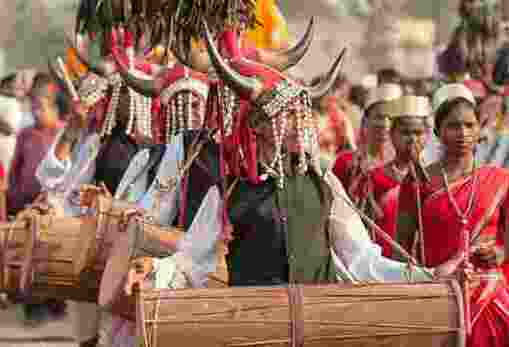
Cherchera Dance on Street by Locals( Source-7)
Origin and History of Cherchera Dance:-
The farming communities of Chhattisgarh are the origin of the Cherchera Dance. For the first time, it was done in order to celebrate the harvest and the efforts of everyone involved. To express gratitude to the gods for the crops and to partake in the joy of harvest, people perform the dance. Over the years, it has become a standard practice at numerous festivals and social gatherings.
How is Cherchera Dance Performed:-
There is a lot of movement and energy in the Cherchera Dance. As they perform, dancers whirl in circles and make various patterns. Here's how to do it:
-
Circle Formation: The dance begins with calm, repetitive steps as the dancers form a circle while holding hands.
-
The dancers' quick footwork involves tapping their feet and twirling in the air as the music picks up speed.
-
Group Synchronization: The dancers create various patterns and designs with their steps while moving in perfect unison. The dancers stay in time with the music's pace.
Instruments Used in Cherchera Dance:-
Cherchera Dance's fast-paced, upbeat music contributes to the thrilling ambiance. Among the instruments that are used are:
-
Dholak: The dholak gives the dance its energy and rhythm, which keeps the tempo quick and constant.
-
Tumbi: A stringed instrument used to enhance music with a melodic layer.
-
Flute: The flute is a supporting instrument that adds a gentle, lovely melody to the drums and other percussion.
Importance of Cherchera Dance for Children:-
Children learn the value of unity and teamwork through Cherchera dance. It demonstrates to them how a team effort can produce something lovely. Youngsters also learn about their cultural customs and how to dance to show joy. It enhances their fitness, rhythm, and coordination.
Khada Nacha Dance
Men from Chhattisgarh perform the powerful and lively folk dance known as Khada Nacha. People frequently do it to demonstrate their strength, bravery, and courage. The dancers exhibit boldness through their movements, stand erect, and move swiftly and forcefully. This dance is typically performed by community members at fairs and other gatherings when they wish to express pride and respect.
Origin and History of Khada Nacha Dance:-
Khada Nacha is said to have originated in Chhattisgarh's warrior culture. Originally, men performed the dance to demonstrate their strength and bravery. It was frequently used in rituals and celebrations where people honored their soldiers or celebrated victories.
Khada Nacha is performed now as a sign of strength and pride. It remains an important cultural expression of valor in Chhattisgarh.
How is Khada Nacha Dance Performed:-
Every dancer moves in time with the drum beat while the ensemble performs the dance. Bravery and strength are symbolized by the powerful and concentrated movements. Here's how to do it:
-
Step 1: Firm Positioning: The dancers begin by placing their feet firmly on the floor and standing in a circle or straight line.
-
Step 2: Strong Motions: The dancers imitate warrior gestures in combat by using strong arms and foot stomps. The calm, purposeful motions convey confidence and strength.
-
Step 3: Group Synchronization: The dancers' coordinated movements foster a feeling of camaraderie and togetherness.
Instruments Used in Khada Nacha Dance:-
Khada Nacha's music is fast-paced and loud, using instruments that complement the dance's strength:
-
Dhol: The big drum provides the dance's strong beat and establishes the rhythm.
-
Tasha: A louder, smaller drum that heightens the performance's intensity.
-
Flute: A flute can occasionally be employed to provide the drums a lyrical contrast.
Importance of Khada Nacha Dance for Children:-
Children learn the virtues of bravery, strength, and solidarity via Khada Nacha. It instills in them the value of remaining steadfast and overcoming obstacles with courage. Youngsters also learn self-control, cooperation, and how to use movement to convey strength and confidence.
Gendi Dance
The Gendi Dance is a joyful, joyous dance performed during Diwali, the festival of lights. The "Gendi" is a long wooden stick that the dancers grip while they spin in a circle. The Gendi Dance is a customary manner for both men and women to commemorate the harvest season and signal the conclusion of Diwali festivities.

Gendi Dance on the Eve of Diwali(Source-8)
Origin and History:-
The Gendi Dance is said to have originated in rural Chhattisgarh, where it was traditionally performed as a Diwali celebration. Over time, it became a significant part of the local Diwali celebrations. The Gendi symbolizes the dancers' unity as they move in sync, and the dance's swirling motion depicts the endless circle of life. A stunning spectacle is created when the dance is often done at night with Diwali lamps lighted.
Performing Style (Steps on How the Dance is performed):-
-
Step 1: Circle Formation: To represent solidarity and togetherness, the dancers start by forming a circle.
-
Step 2: Spinning Motions: The main element is the spinning motion, in which the dancers spin while gripping wooden sticks called gendi.
Musical Instruments Used:-
-
Dholak: Directs the dancers through the spinning moves and sets the beat.
-
Flute: Provides a musical overlay by using soft notes to calm the frantic movements.
Significance for Children:-
The Gendi Dance emphasizes the value of community and togetherness during festivals while teaching kids about the joy and togetherness of celebrating Diwali. Children are encouraged to engage in physical exercises through the dance, which enhances their coordination and balance. Additionally, it educates children to the beauty of cultural expression and the Diwali symbolism of life and light. The Gendi Dance encourages self-expression, inventiveness, and a respect for Chhattisgarh's festival customs in young dancers.
Why Are Folk Dances Important in Chhattisgarh
The traditional dances of Chhattisgarh are more than just a delightful activity to participate in. Both during events and in their everyday lives, people make extensive use of them. They are linked to the customs that are prevalent in the state. It is clear from this what they mean:
- These dances are inextricably linked to tradition and, therefore, contribute to the preservation of the rich cultural legacy of Chhattisgarh by passing on the customs and principles that have been passed down from generation to generation.
- Observances and Narratives: Several traditional dances are used in the state of Chhattisgarh to tell stories about the gods, nature, and the usual activities of the people who reside there.During celebrations and ceremonies, people do them frequently in order to pay homage to the gods or to recall significant occurrences.
- Folk dances are a good means through which people can come to know each other. The idea behind such functions is to gather people together and make them feel that they belong to a group, whether it is a party or a festival.
- Dances of Happiness and Gratitude: Such dances are a way people express thanks for everything that nature has offered to man, usually during harvest or holiday festivities.
Folk dance is a means by which people in Chhattisgarh impart knowledge about their culture to their children and subsequent generations. People do these dances on a regular basis; they are not merely done for performances.
Cultural Significance of Chhattisgarh Folk Dances
The folk dances of Chhattisgarh are more than just a way to enjoy fun. They are the crucial aspects of the history and cultural diversity of the place as well as connecting themselves to nature. Such performances hold significant importance for upholding local traditions and accepting the area's rich history. Each type of performance based on myths, seasonal change, or rituals reveals values and traditions of places it is performed in.
These themes and performance styles show how close the tribal people in Chhattisgarh are to nature. They form a monument to the rich cultural landscape of the state. Folk dances in the state are integral to social life as most of them are performed as part of religious events, agricultural festivals, and community gatherings.
Relation with Festivals, Seasons, and Traditions:-
- Folk dances in Chhattisgarh are seasonal expressions that are closely associated with the cycles of nature and agriculture.
- The Karma tree, which is identified with the harvest cycle and the wealth it brings, is celebrated in the Karma Dance.
- Similarly, the Saila Dance is performed to celebrate the rich harvests during harvest.
- On the other hand, the Pandavani dance plays an important role in the traditional rituals and celebrations associated with storytelling.
- Apart from being ceremonial performances, the dances demonstrate the love of a community to its ancestors, gods, and goddesses. The dances have symbolic roots and can be a plea for rain, a celebration of harvests, or an expression of gratitude for abundant crops.
Impact on Community Bonding and Storytelling:-
- Folk dances can help create a sense of community by creating a feeling of bonding in participants. Since folk dances are social activities requiring coordination and cooperation, participants bond more with each other when participating in these dances. Most of these dances have been performed at community festivals, where friends, family, and even complete strangers get together to rejoice and share stories.
- Other folk dances, such as Pandavani, also preserve the story and tradition that has been handed down for centuries, serving as narrative tools. Pandavani is famous for its narrated dance, wherein the dancers enact scenes from the Mahabharata in an over-the-top, passionate manner while a male narrator narrates it.
- Folk dances are a great chance for kids to learn about the culture of their ancestors, the connection of their roots with them and develop an affinity for the heritage of the people of their culture. Apart from developing creativity and physical skills, these dances help the children develop coordination, self-control and teamwork. Just like physical skills, self-control, and teamwork are great skills that folk dance teaches kids. Similarly, our Dance lab helps kids develop these skills.
Welcome to our Dance Lab: Where Creativity Takes the Stage
Discover movement, self-expression, and innovation as we redefine dance. Enter a world where every step matters.
How to Experience Folk Dances of Chhattisgarh
Well, if you really want to know a complete detail of people's experience and the understanding of its own traditions, here are all those ways, both when he is native to there and when visiting Chhattisgarh, so many chances that they observe these folk dances are living before their own eyes.
Go to Festival Such As Karma, Navratri And Diwali:
- The folk dance of chhattisgarh are very lively and vibrant when danced during festivals. When the rainy season is near, there is the Karma Festival. It is one of the biggest culture events of the state. Nature, fertility, and community spirit are all celebrated, and the Karma Dance is part of the events. Many festivities also witness tribal dances, like Khada Nach and Pandavani, at their best.
- The Gendi Dance is a dance which is performed during Diwali, which is all bright spinning and rhythmic beats that light up the night. If you're lucky enough to be in Chhattisgarh during these happy times, you can see these dances in all their glory, with all the music, lights, and happiness that these events are known for.
Explore Performances in Local Villages or Events:-
You can watch local performances in villages, cultural centers, or theater events organized by the state government or cultural institutions if you cannot manage to attend during festival times. Folk dances are performed throughout the year in several villages of Chhattisgarh, and tribal community groups often host events to display their dance traditions. Watching these shows is a great way to learn about the real and varied dance culture of the area.
Wrap Up
Chhattisgarh has a lot of history and culture. Folk dances are more than just shows; they show the history, morals, and social life of the state. Every type of folk dance has a story to tell, from the happy steps of the Raut Nacha to the spiritual steps of the Panthi Dance. These dances not only keep traditions alive but also bring people together, get people moving, and teach future children about other cultures.
Looking into folk dance of Chhattisgarh is a great way to get to know the many cultures of the state, learn how nature and community work together, and enjoy the lively traditions of India. Get to Chhattisgarh and watch its folk dances for yourself if you ever get the chance. This beautiful state is known for its cultural diversity.
Liked what you read? Then, kindly share this blog with your friends and relatives who are interested in the “Famous Folk dances of Chhattisgarh!
Other Related Sections
NCERT Solutions | Sample Papers | CBSE SYLLABUS| Calculators | Converters | Stories For Kids | Poems for kids | Practice Worksheets | Formulas I Parent Resources
Also Read
A Complete List of the Folk Dances of Bihar | Explore Bihar's vibrant folk dances!
The Origins of Panthi Dance: Unfurling the Historic Roots | Discover the roots of Panthi dance!
Frequently Asked Questions
Answer: There are 10 major folk dances from Chhattisgarh that show off the state's rich history and culture. Pandavani, Raut Nacha, Karma Dance, Saila Dance, and Suwa Dance are some well-known ones. Folk dances come in a range of styles and have different meanings.
Answer: Saila Dance is a dance which the people of Chhattisgarh perform after harvesting. The primary reason behind the performance of tribal people is that they want to thank nature for the good crops. The dancers are happy and work together while moving in circles to the tune of the music.
Answer: Raut Nacha is the most significant folk dance of Chhattisgarh. The Yadav community performs this energetic and exhilarating dance to worship Lord Krishna. It is mainly performed during festivals like Hareli and Tihar.
Answer: Bostar Dussehra is the most important festival of Chhattisgarh. Bastar Dussehra is unique compared to other Dussehra festivals in India as it has specific customs and lasts longer. It is a celebration of the tribal culture, nature, and gods of the region.
Answer: "Sohar" is the folk song title by Chhattisgarh. Similar folk songs can be well heard in a celebration or festival and on weddings as well. Such songs comment on nature, harvest and daily activities that go in the village.
Answer: Kaksar Dance. The Kaksar Dance is a traditional folk dance that is done by tribal people in Chhattisgarh. It is a religious dance that shows respect for the gods.

